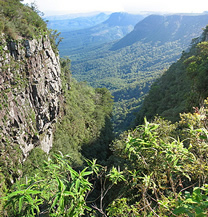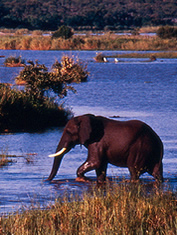Lowveld

The main communication node in the northeast of South Africa is the small provincial capital of Nelspruit, and the signature feature of the region is the world famous Kruger National Park. Nelspruit is the first port of call for anyone looking for a trip into the park, and is well serviced by backpackers lodges, luxury lodges, B&Bs and hotels. It is also the jumping off point for trips north into the northern, or Klein Drakensberg. The Klein Drakensberg is something of a smaller brother to the main berg, and home to the Blyde River Canyon, the famous Sudwala cave complex, and a handful of smaller destinations in the highland escarpment like Graskop, Hazyview and Pilgrim’s rest.
 Klein Drakensberg
Klein Drakensberg
Nelspruit is poised on the lip of the Klein Drakensberg escarpment, and is in a typical lowveld setting, with dry and open thorn savannah with a proliferation of aloes and other succulents. The city is clean and well ordered, if perhaps a little on the sterile side, with a strong demographic mix of both black and white.
The escarpment itself, and the hinterland of high plains and tolling hill country, is characterised by open grassland with stands of indigenous forest in gullies and other limited areas, with much of the landscape being dominated by plantation conifer forests which is an enormous industry in South Africa. Look out for the handful of pioneer settlements in the area, and the vast and spectacular Blyde River Canyon.
 Kruger National Park
Kruger National Park
To the east the landscape plunges an average of 1500m meters to the low lying flat lands of the lowveld. This is the signature bush country of Africa, and home to the Kruger/Limpopo TransFrontier Project, one of the largest and most ably administered national park systems in Africa.
A number of private game parks and conservancies augment the much larger institution of Kruger, offering smaller reserves, some adjoined to Kruger itself, and a range of luxury facilities including rated accommodation and top flight guides. The big five are virtually guaranteed at most of these locations. Other local attractions are birding and Agritourism within and around the unique ecology of the lowveld.
Road Touring
The region sits astride the N4 toll road heading east to Maputo and Moçambique. Between Nelspruit and the Moçambique border at Lebombo runs a superb black top freeway that passes through some of the most lovely countryside in South Africa. Look out as you drive for the spectacular Crocodile River gorge.
Sights to see
- National Botanical Garden Nelspruit
- Kruger & Great Limpopo
- Nelspruit
- Sudwala Caves
- Pilgrim’s Rest
- Blyde River Canyon
- Hazyview
Climate
The Klein Drakensberg escarpment shares the same climate characteristics as the main Drakensberg at similar altitudes, receiving a bounty of summer rainfall. Most of the year it is cool, with cold winter (June-Sept) temperatures. Average maximum 15°C – 60°F and minimum 1°C- 33°F. And mild to warm summers. Average Maximum 23°C – 74°F and minimum 12°C – 54°F.
The Lowveld is much warmer with an average summer (October-March) maximum of 30°C – 90°F and an average low of 19°C – 66°F. Winters are cooler with average highs of 23°C – 73°F and 6°C – 42°F.
When to Go
The region is pleasant and accessible all year round, with the lowveld tending to be hot and humid during the summer months. The best time to visit Kruger National Park is during the dry winter months when the temperatures and humidity are lower, and when wildlife tends to gather at the permanent waterholes thanks to the scarcity of water in the bush. This affords usually the best chance of frequent and varied sightings. During the summer school holidays the park can get crowded, so advance research and booking is advisable.
Travel Warnings
Crime: The Lowveld and Klein Drakensberg region shares the same general dangers of street crime and muggings as the rest of South Africa. Don’t be fooled by the isolation and backcountry atmosphere. Keep your wits about you at all time, and remember that South Africa is one of the most dangerous countries in the world. There are certain areas that are more dangerous than others, and although Mpumalanga is not the most dangerous part of the country, nowhere is particularly safe on the streets after dark, so seek and follow local advice on the matter of crime and general safety wherever and with whomever you go.
- Leave important documents in a safe place. All hotels, lodges and hostels offer safe lock up facilities
- Seek safety advice from you hospitality establishment wherever you are
- Avoid walking anywhere after dark, particularly in urban areas, and particularly in the CBD of any of the larger cities and towns
- Don’t leave anything of value in your car overnight
- Incidences of car hijackings in South Africa are high. Always be aware of your surroundings, particularly at night
- Don’t stop on any of the freeways for more than a few minutes, and in the instance of a breakdown, call for help
Health
AIDS: Any kind of casual sexual encounter in South Africa, as with anywhere in the world these days, is to be discouraged. South Africa has one of the highest infection rates on the planet, about 1 in 4 of the population, so obviously extra caution is necessary when visiting any destination on the sub-continent.
In most of South Africa tropical diseases are rare, but in Mpumalanga, and anywhere adjacent to the Mozambique border, malaria is an issue. A traveling mosquito net is always a good option, as is the necessity of staring a course of anti-malarials at least two week before you visit. During the summer there are many flies biting insects, so a good repellant is a worthwhile investment, and carry a small medical kit for cuts and scrapes that can turn septic.
Travel Doctor clinics are to be found in all the major centers where you can get health advice on malaria, yellow-fever, AIDS and any other tropical diseases, and acquire all the vaccinations and prophylactics necessary for your extended journey.
Tap water is usually safe to drink.
Sunburn risks are high so hats, long sleeved T-shirts and sun screen are a must.